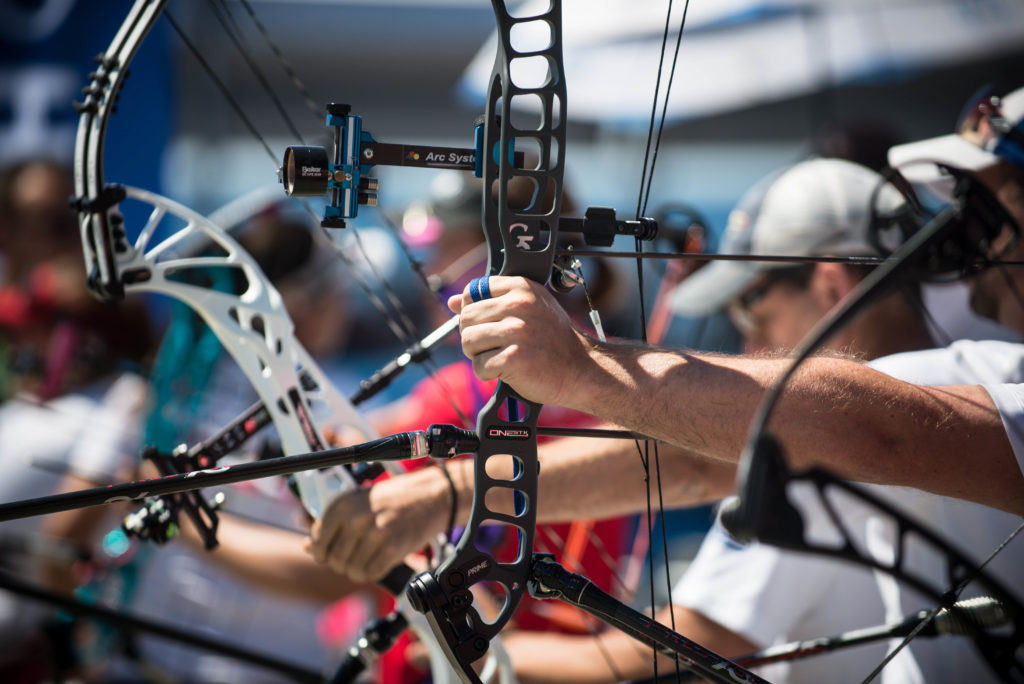
By Duncan Busby, who likes to keep things balanced.
Look along any shooting line and you will see an entire row of stabilisers pointing towards the target. These are not actually essential to shoot a bow, but you will see every compound (and recurve) archer with one. So why shoot with a stabiliser at all, and what do you need to consider when choosing one?
A stabiliser has three main purposes; firstly and most importantly it helps you to maintain a steady hold on the target, much like a tightrope walker who holds out a long pole, it helps to maintain balance and slow down movement.
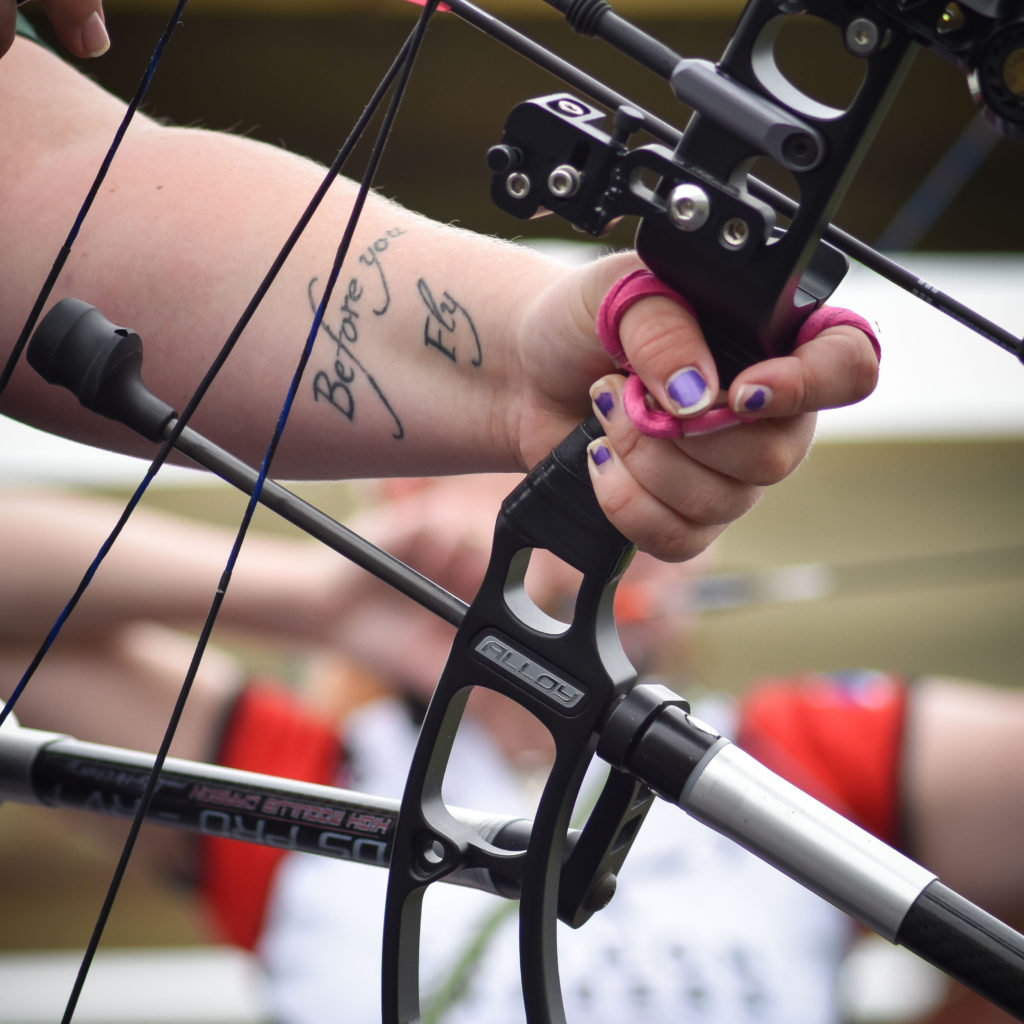
Secondly, it directs the momentum of the bow upon release, eliminating any torque and uncontrolled movement. And finally, it dampens the vibration in the bow when the arrow is released; this is less crucial when it comes to accuracy but it’s very important to the comfort and ultimately the long term physical health of the archer.
Do I need a compound-specific stabiliser?
Most manufacturers do not differentiate between compound and recurve stabilisers, though because compound bows expend more energy and stress upon release they require a much tougher and more rigid stabiliser. Rods made with ‘high modulus’ carbon to make them strong and stable are able to hold more weight and will dampen any vibration at a much higher frequency, this makes them much more effective for compound shooting.
They don’t need to be heavy or over-sized either; basic mass weight can range from between 12oz to 19oz (350g to 550g) before additional weights are added, and modern technology advances mean rod diameters can be as small as half an inch without losing any strength or rigidity.
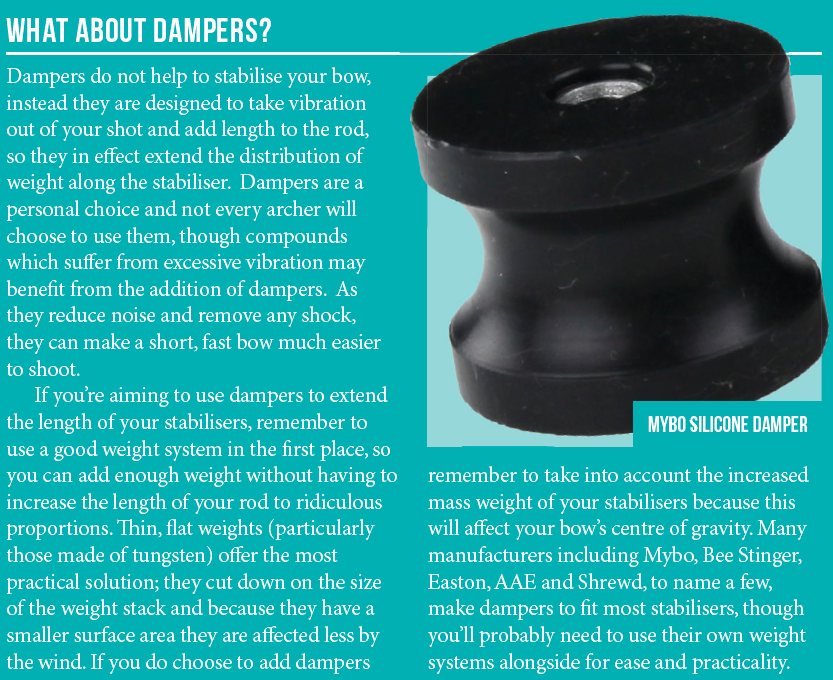
So it’s best to look out for products that are of high quality, and many companies are employing high-precision machining and high-tech parts these days. Doinker in particular use their technology to not only produce aerospace parts for the US government, but to make stabilisers to an even higher level of adjustable precision.
For British made quality, have a look at Mybo’s stabilisers which feature ultra-stiff carbon shafts able to accommodate heavy weights for maximum rigidity.
How many stabilisers do I need?
A front rod is considered essential to any compound setup whatever discipline of archery you prefer to do, but you can also choose to add one or two side bars to your setup; these are mounted to the riser usually just below the grip. Nearly all compound bows come out of the factory with several threaded accessory holes, so you can choose exactly where you would like to mount your rear bars.
There is no real benefit of using one side bar over a V-bar setup other than the lighter overall weight. Some archers can find it easier to stabilise a bow with two side bars as it offers greater choice in how weight is positioned around the bow.
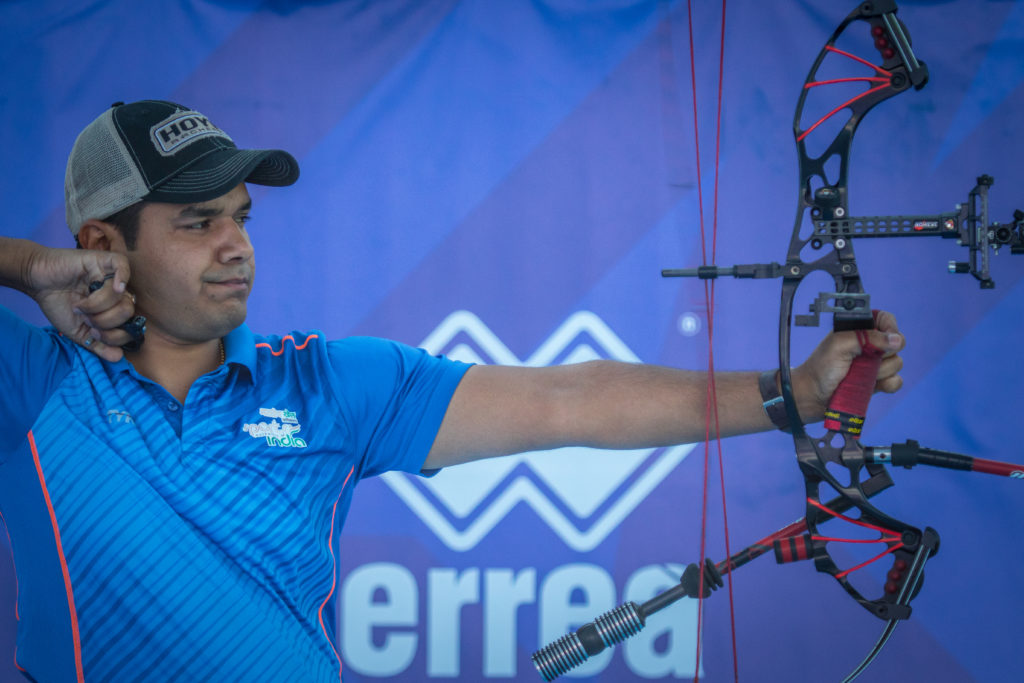
Your choice of side bars is as much dependent on how much torque you put into your bow as is your style of shooting. Archers who twist their bow at full draw and those who suffer from anything but a rock-steady aim can benefit from experimenting with some back weight, just remember adding stabilisers isn’t going to instantly make you a better archer, they are purely designed to improve instability in your setup.
Target archers usually need at least one side bar to counteract the weight of their sight, likewise hunters and some 3D shooters will usually need to offset the weight of a bow-mounted quiver.
Just think about how and where you shoot, what targets you’ll be aiming at and how your bow behaves, then try experimenting with different lengths and combinations to see which stabiliser setup suits your needs.
What size stabilisers should I use?
As a general rule the longer a stabiliser is, the more it’s going to steady your aim and resist bow torque whereas the shorter a stabiliser is, the better it will be at reducing noise and vibration. Each option will suit one discipline over another; target archers generally need the stability and accuracy of a longer stabiliser.
This is not to say that you should use the longest stabiliser you can find, there is a fine balance between being able to practically touch the target with the tip of your long rod and not being able to aim because your stabiliser is so short and unstable.
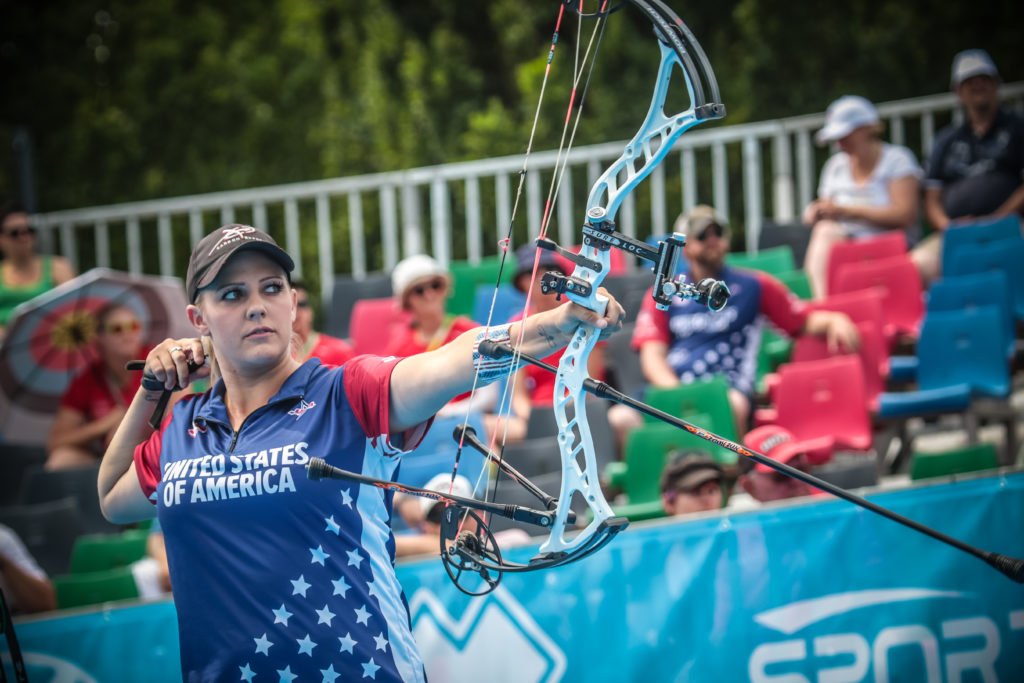
In the 90’s, very long front stabilisers upwards of 45” long, with little or no weight on the end, were very popular. But the main drawback, aside from practicality, was that they suffered from instability in the wind. They offered very little mass weight and they had such a large surface area that they were very easily blown around.
Nowadays target archers tend to favour shorter, thinner stabilisers between 28” and 34” long with a good amount of weight added to the end. Getting this balance right allows an archer to alter their sight picture and as result positively affect their aim.
Your dot or pin will always move around the target at full draw, even if the movement is faint, so being able to control the speed at which it moves simply with your choice of stabilisers is an important factor to take into account.
Longer stabilisers at the front and rear of your bow have a wider weight distribution which will result in a slow moving sight picture, whereas shorter stabilisers, where the weight sits closer together, will usually produce a faster sight picture.
As it’s highly impractical to have a 30” side bar out the back of your bow, I’d recommend a length of around 10” to 15” long with additional weight added on your front rod to maximise stability for target shooting.
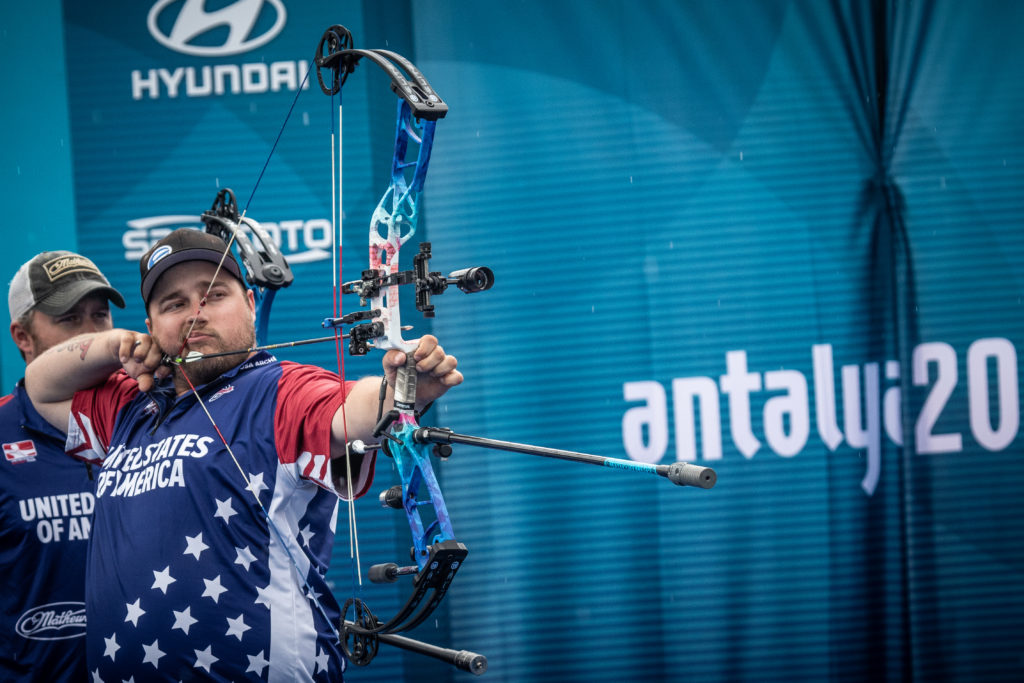
Those competing under NFA rules will need a front rod of no more than 12”, as the longer rods used by target archers are extremely impractical when you’re trekking through forests and sitting in tree hides.
The small, fast compounds used by these disciplines also need the extra dampening qualities of a small stabiliser; just remember that you will generally need to add more weight to a shorter rod as the fulcrum point or centre of gravity is much closer to the bow.
How much weight should I add?
There are two styles of stabilisation among compound archers; those that use a resistance method of aiming and those that balance their bow neutrally. The first relies on a large amount of front weight to create a downward force which the archer must resist.
This constant fight against the forces of the bow supposedly creates a steady sight picture, but as a downside it can pull the bow down the target, causing a dipping action while you aim and the occasional low arrow.
Using a balanced approach to stabilisation requires a large amount of mass weight to be added to both the front and rear of the bow, this steadies the bows movement and creates a much more stable sight picture as your bow is not being pulled in any particular direction.

As a downside this style of stabilisation makes the bow much heavier to hold, so if you’re not very strong you may struggle with a great deal added weight.
Achieving a steady hold is by no means a simple task, and the amount of weight you choose to add to your bow is dependent on your strength, the inherent behaviour of your bow and your style of shooting. Some archers consider a lot of weight at the rear of their bow makes it more stable while others believe it makes their bow less reactive and produce less shot feedback.
So again, experiment and find out what works for you, just remember what works in practice might not necessarily work in competition or high pressure situations, so be prepared to make adjustments as you go.
Most manufacturers sell their own weights with their stabilisers; these are made from steel or aluminium and occasionally from tungsten. They can range anywhere from around 1oz to 3oz for a single weight and you can add as many to your setup as you can humanly handle. I’ve seen pro shooters stack up to 30oz of weight on the end of their long rods.
Doinker offer a large range of adjustable weight systems, in a multitude of colours and styles, just make sure you choose weights that can be adapted to your stabiliser setup.
Where do I position rear stabilisers?
Where you position your stabilisers is highly dependent on where the stabiliser bushings are on your bow. Though generally speaking placing side bars higher on the bow, directly behind your front rod (either in the rear bushing or in the front bushing on a V-bar mount) tends to make the bow more reactive.
This produces more shot feedback and a quicker sight picture, alternatively positioning and your bow will cant and aim off-centre. Just make sure any angle you choose has a practical purpose and it doesn’t cause problems with your results.
What about stabiliser accessories?
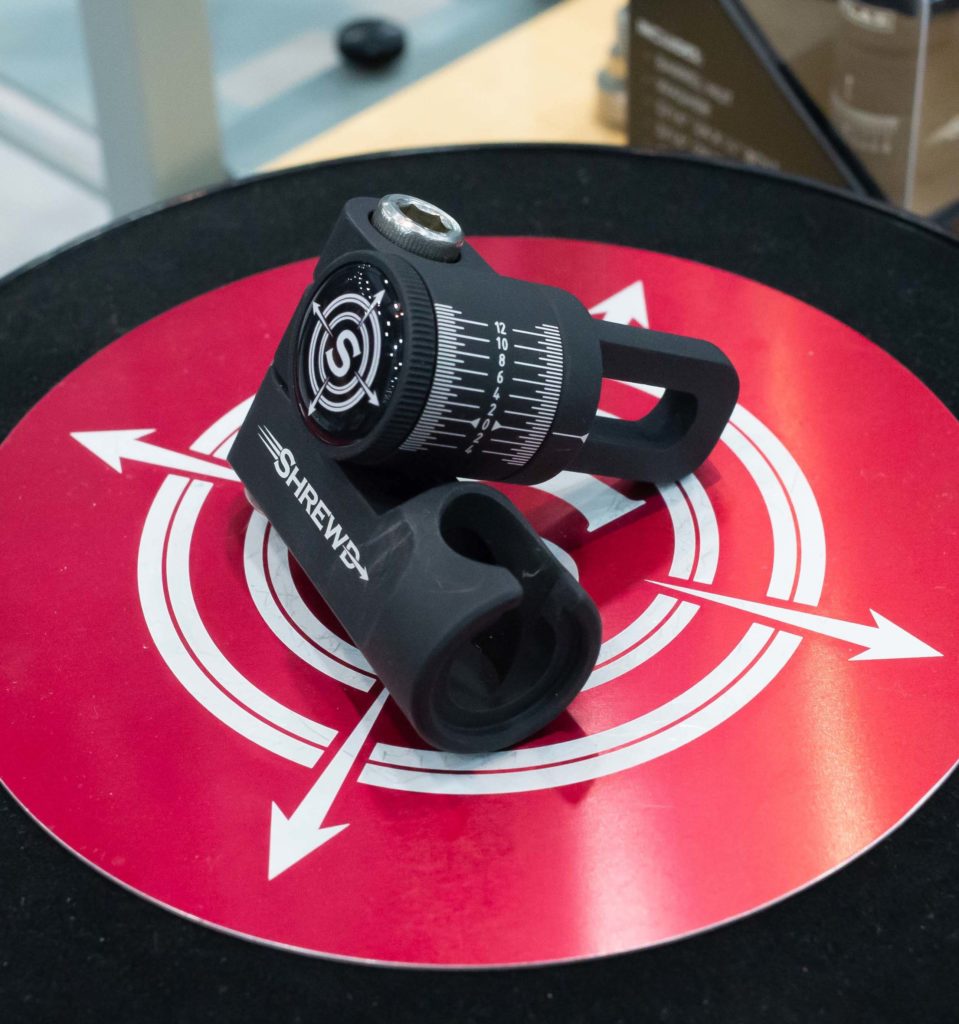
Most stabiliser manufacturers also produce a range of mounts, in either a V-bar or offset bracket configuration; these can allow you to adjust the angle of your front rod as well as the position of any rear bars you may use.
So make sure the one you choose has a good range of adjustability and that it is solidly built; you don’t want your stabilisers moving out of place while you shoot.
You can also consider customising your stabiliser with a wrap, coloured weights and dampers; these won’t improve the performance of your setup but they’ll certainly make you stand out on the shooting line.
Extenders are best suited to recurve bows; they are designed to change your bow’s centre of gravity, by bringing the stabiliser mounting point forward. The forces and energy produced by a compound bow coupled with a heavy stabiliser setup will prove to be too much for most extenders, so try and avoid using one if at all possible.
The stabiliser market is huge and there is enormous choice available when it comes to size, weight, material and price. Ideally we’d like to find one that fulfils all three purposes of a stabiliser, but the one you choose will be highly dependent on you and the bow you shoot.
Our size, shape and strength is unique to us, this means that we will all put our own unique set of forces onto a bow when we shoot it, so a stabiliser set-up that works for one archer will not necessarily work for another.


Fantastic information thank you
Thank you for your writing. This is very better than many other article on the stabilization. Your specifics of length and the placement will help someone new to archery.
I have seen quick connects for stabilizers that are 8 degree down. Should these be applied at the long stabilizer connection or at the bow to extender connection?